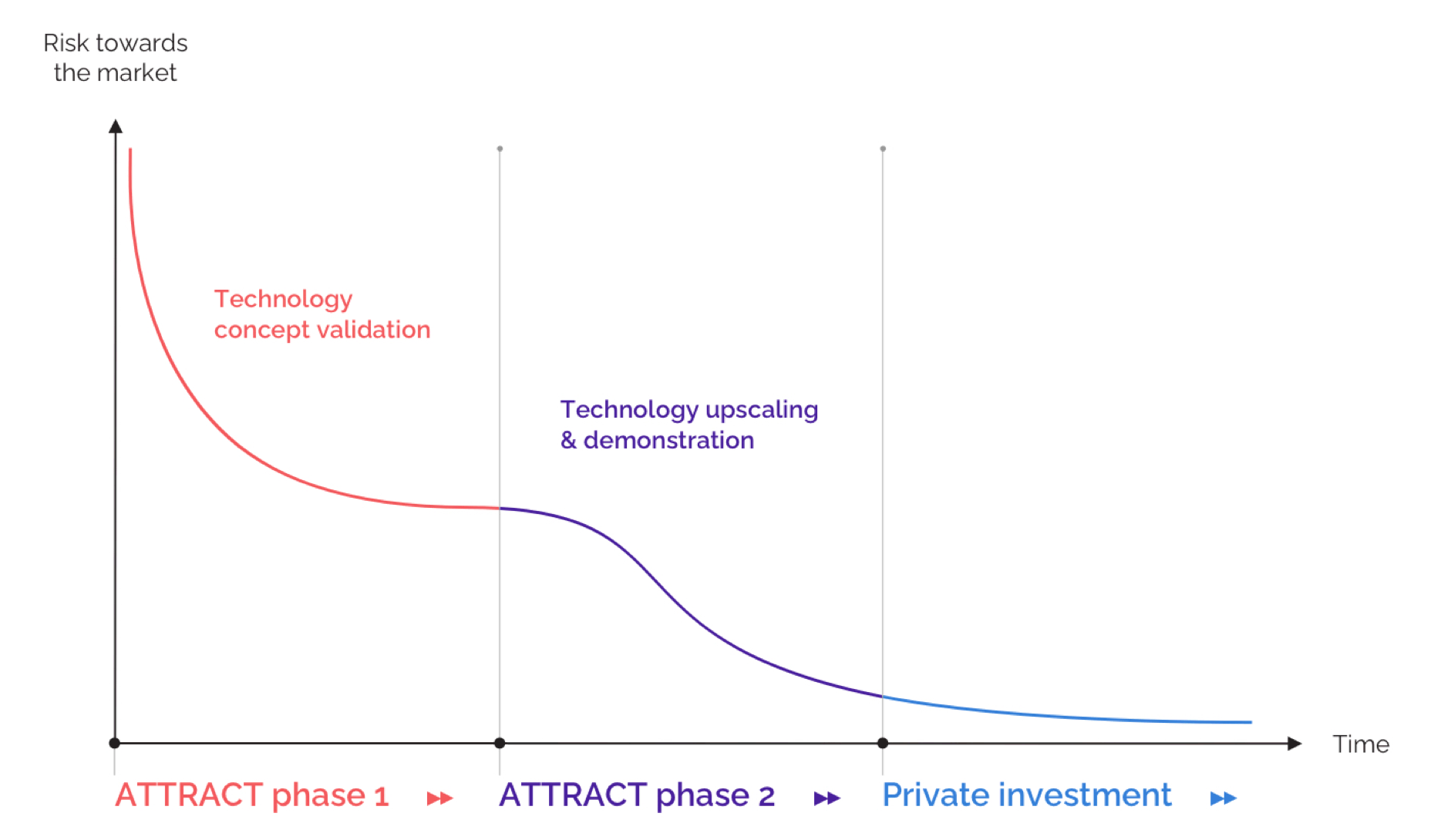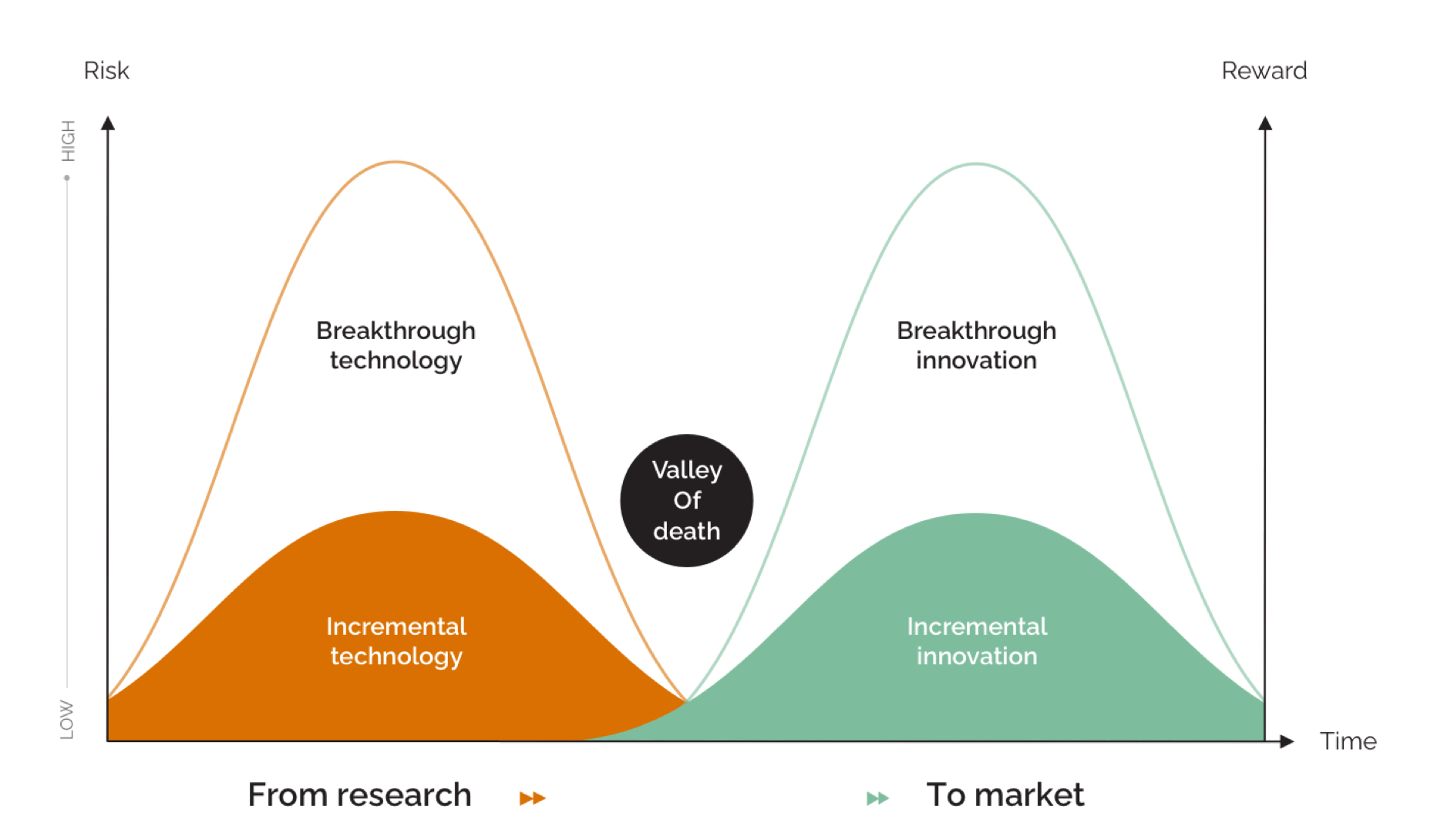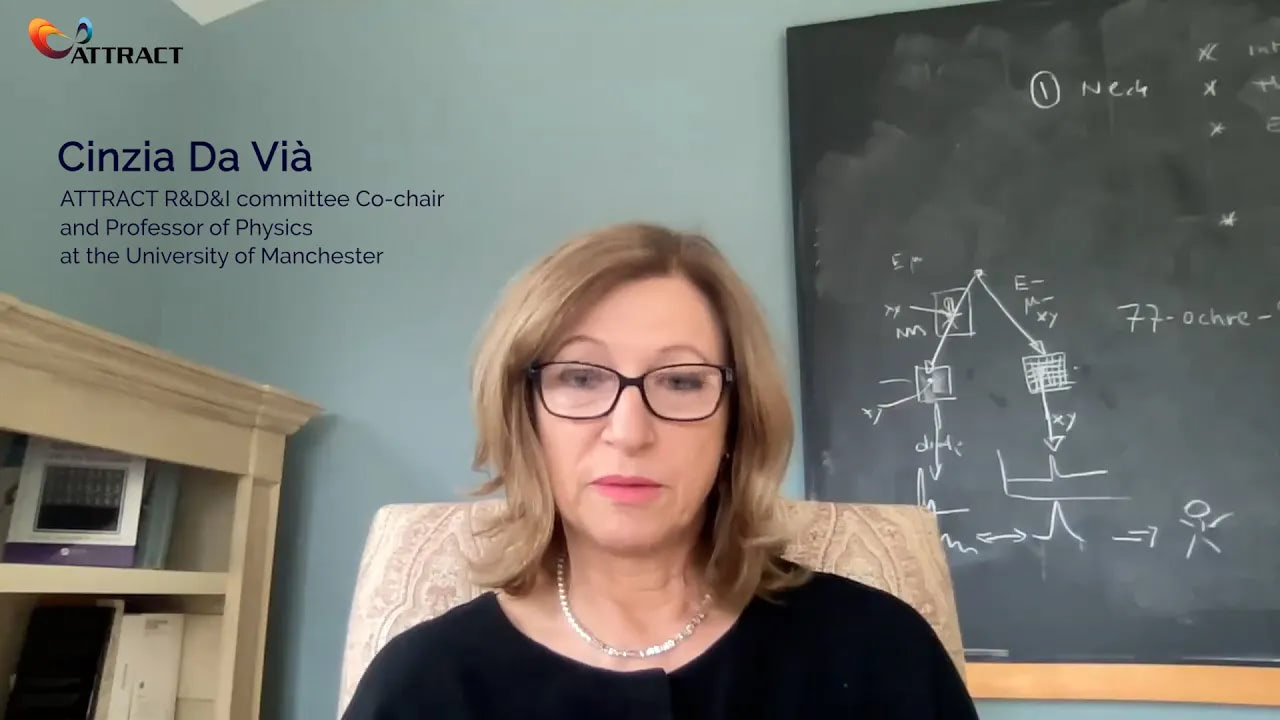Summary & highlights
ATTRACT Phase 2

Departing from the success of phase 1, ATTRACT phase 2 focuses on and funds the proven and most promising breakthrough technology concepts from the previous phase showing strong potential for scientific, industrial and societal applications.
Additionally, this phase is also scaling up the opportunities for young entrepreneurs concerning and will also deliver a first-of-a-kind Socioeconomic Study of an innovation ecosystem in the making, realised by top experts and addressing different points of view and practices.
ATTRACT Q&A
R&D&I projects
The ATTRACT Consortium uses public funding to lower the intrinsic risk that breakthrough technology bears as it moves along technology readiness levels (TRLs) and reaches private investment and the market.
Lowering risk is achieved in two phases (Fig. 1):
- Risk absorption (ATTRACT phase 1): ~TRLs 1 to 4.
- Risk reduction (ATTRACT phase 2): ~TRLs 4 to 7.

After reaching a stage around TRL 7, breakthrough technologies – thanks to public funding – will have been sufficiently de-risked to become more attractive to private funders. At this point, ATTRACT phase 2 will be completed, and private investment will help to commercialise new products and services for society.
During ATTRACT phase 2, data will be collected and analysed for a socio-economic study. This will assess whether ATTRACT phases 1 and 2 succeeded in streamlining the element of “chance” when upscaling breakthrough technology concepts.
The study will provide useful insights on whether a potential scaling of ATTRACT phases 1 and 2 to other research fields would provide significant and quantifiable value for Europe. It will also provide interesting knowledge about how breakthrough technologies can overcome the “valley of death” (Fig. 2):

For science policy, ATTRACT phase 2 offers an opportunity for studying the construction of an innovation ecosystem. In this context, ATTRACT phase 1 was mainly focused on identifying and initiating interlinks among a community of actors. ATTRACT phase 2 will focus on consolidating these interlinks (Fig. 3):

Phase 2 will also scale up activities involving young innovators. During ATTRACT phase 1, 100 young innovators interacted with some of the projects and then conceptualised and prototyped new technological solutions linked to the UN Sustainable Development Goals. Now, in phase 2,400 young innovators will be involved.
Student projects
Upscaling the ‘Young Innovator and Entrepreneurs’ pilot.
One of the activities in ATTRACT phase 2 is the upscaling of the ‘Young Innovator and Entrepreneurs’ pilot from phase 1, in which students from Aalto and Esade applied design thinking methodologies to some of the ATTRACT projects’ technologies to solve societal challenges.
Using the three existing pilot locations at Aalto, Esade and CERN from ATTRACT phase 1 as starting locations, phase 2 will increase the number of universities and students. In this case, the project will provide up to 400 young innovators with the opportunity, methodologies and mentoring for developing novel concepts and prototypes of technological solutions addressing Societal Challenges inspired and in collaboration by the detection and imaging technologies developed within the funded projects.
The inclusion of student projects in ATTRACT phase 2 is designed to create a new generation of researchers who perceive co-innovation between academia, research infrastructures, and commercial organisations as a natural way of working.
The student projects are intended to foster a stronger entrepreneurial culture across Europe that uses the concepts and resulting technologies created for research purposes as the starting point for developing products and services for our citizens.
Socioeconomic studies
Evaluating the benefits of deep-tech for Europe’s economy.
ATTRACT phase 2 will include socioeconomic studies to investigate the micro and macro socioeconomic impact of ATTRACT on Europe. The studies, coordinated by Esade Business School, will investigate and identify:
- Critical factors for vibrant innovation ecosystems.
- Best practices to embed the ATTRACT paradigm across the detection and imaging landscape, and to reduce its reliance on public sector funding.
- Europe-wide conditions and requirements that will turn the upscaling of breakthrough technologies into drivers of social inclusiveness, gender equality, skills development and the reduction of geographical disparities.
The socioeconomic studies will provide further proof of the various industrial, financial, education and cultural spill-over effects from the construction and operation of research infrastructures to policymakers, companies and public citizens.
ATTRACT phase 2 will launch an open call for specialists to carry out several studies. Each will involve individuals and organisations with expertise in researching the socio-economic impacts of big research infrastructures and innovation ecosystems.
The conclusions of the studies will become an important input for national and European policymakers in the development of future research and innovation policies.

Phase 2 in a nutshell
proposals
Almost 70 proposals applied for the Thematic call and 18 were chosen to achieve a pre-industrial level.
R&D&I projects
These projects were chosen to advance the proofs-of-concept from phase 1.
students
Through the Student Programs under ATTRACT Academy, more than 1300 students have participated.
disciplines
Students that participate within ATTRACT Academy come from 75 different disciplines.
Socioeconomic Studies
Through these studies, it will be possible to measure what is being done within the ATTRACT ecosystem and its scale-up.





